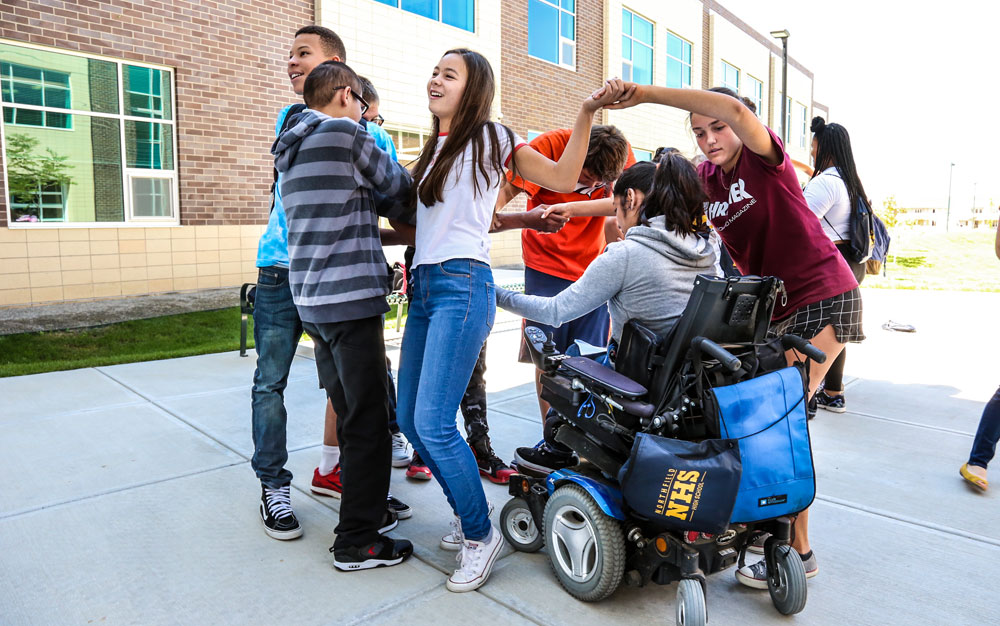
Northfield High School ninth graders participate in a team building activity at the Ninth Grade Academy during the week before school started.
Full IB diploma? IB access for all? A full schedule of AP courses? A mix-and- match approach to AP? Focus on the arts? STEM curriculum? College-bound high school students have a lot of options to learn about and choose from—and NE Denver students have five good public high schools to choose from.
Denver Public Schools’ “Choice” system allows students to request schools outside their neighborhood boundaries—and many students do just that, particularly at the high-school level. In the Northfield boundary area, 31 percent of students chose their boundary school this fall. Thirty-three percent selected East or George Washington as their first choice—and those students all got into their first choice school.

Northfield High School 9th graders cheer as teachers are introduced during the Ninth Grade Academy the week before school started
The top five high schools chosen by Northeast Denver students (alphabetically)—Denver School of the Arts (DSA), DSST: Stapleton, East, George Washington (GW) and Northfield High School (NHS)—differ greatly in size and offer distinctly different options for college-bound students.
How can students and families find the best fit?
The best advice for finding a good fit is start early and spend time in the schools. “The shadowing piece is important,” says NHS IB Coordinator Micah Porter. “You can walk into any school in the country and you get a sense of how it operates on a day-to-day level.”
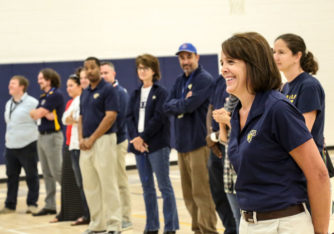
Northfield HS principal, Amy Bringedahl, and staff meet incoming students.
East and GW say they offer a limited number of slots for shadowing and they go fast. East Principal Andy Mendelsberg says when they open up scheduling at the beginning of September, “We get calls all day long. We fill up usually within the first week of posting shadowing availability.” Northfield did not fill up last year and says they would likely add slots, if needed, to accommodate all requests. Denver School of the Arts offers shadowing but their application deadline is earlier than other schools so scheduling early is desirable. DSST does not offer shadowing.
Principals and staff recommend not only shadowing, where available, but attending parent and student information sessions and tours. But just as important is talking to parents of students to get real life information. “What I’ve noticed for the parents at East is they’re really true advocates—or they’re really true—and not just advocates. They also give the negative pieces of schools — what the struggles are and whether the schools try to fix those negatives. Whether it’s East or any of the other schools, nobody’s perfect,” says Mendelsberg.
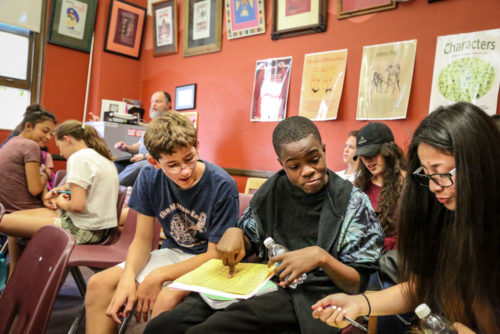
Wyatt Mandear, Navon Powell and Nina Poot from Hill Middle School ponder the schedule at East High 9th Grade Academy.
DSST: Stapleton (Denver School of Science and Technology) offers a science, technology, engineering and math (STEM) curriculum. Since they opened eight years ago, 100 percent of their graduates have been accepted to four-year colleges. They have also ranked number one in Denver for ACT scores during that time period.
East High School, with its long history in NE Denver (it opened in 1875), is well known for its comprehensive offerings in classes (advanced placement (AP), honors and regular), athletics and numerous other extracurricular activities. Principal Mendelsberg points out that incoming ninth-graders are required to take honors geography to set a high bar for all students. “At East, all of our AP classes are completely open enrollment, which means, if you would like to take the class, you absolutely can.” He says if kids are struggling, East tries to keep them in the class and help them succeed. In the past five years they’ve increased their AP enrollment by over 300 kids and they’ve increased their test scores. East’s graduation rate is 92 percent with 90 percent of those going to a two- or four-year college, says Mendelsberg. The biggest of the five schools, East has about 2,500 students.
Denver School of the Arts, the only one of the five high schools that requires prequalification, is an art intensive magnet school. It requires auditions for its 11 different art majors. Interested students need to check the application and audition schedule since it differs from the late January date for DPS Choice.
George Washington, like East, offers a wide array of AP and honors classes and extracurriculars. AP classes offer students the opportunity to customize their schedule and focus more heavily in certain areas, maybe science and math, but not take AP in all areas.
Northfield High School and GW offer the final option for college bound students in northeast Denver, the International Baccalaureate (IB) program. The IB program has a mandated interdisciplinary curriculum that is taught throughout the world and is recognized by colleges as an academically challenging program—but the two programs differ in their implementation.
How do the GW and NHS IB programs differ?
International Baccalaureate at George Washington
In all IB programs, the actual IB curriculum comes in the 11th- and 12th- grade classes, taught by IB certified teachers. Ninth and 10th grades are pre-IB years in which students are encouraged to take courses with lots of reading and an emphasis on critical thinking and critical writing, says GW IB Coordinator Melanie Bryant. IB students at GW take their core classes together but take their one or two elective courses a year with non-IB students. In the past about 100 students per grade have enrolled in the IB program at GW. The current ninth grade class has about 420 students.
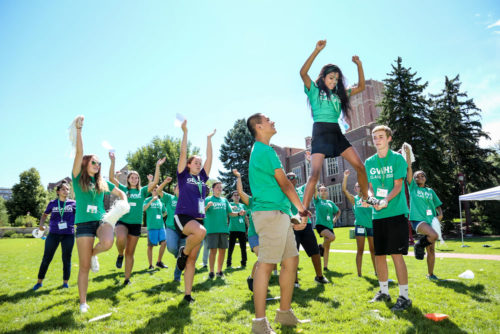
GW Incoming 9th graders do team building exercises at their 9th Grade Academy which was held on the campus of Denver University.
In years past, GW had a structured program that required students to start in middle school taking honors and higher-level courses to prepare for the rigorous requirements of their IB program. Starting last year, they opened the program to interested ninth graders who had not taken higher-level courses but wanted to be in the IB program.
“They may not feel as prepared, so (once they get to GW) we really do encourage kids who want to go into the IB to take as many honors courses as possible,” says Bryant. But, she adds, “We do have lots of support built in—we’re attempting to build in ever more support for students who come in and they’re motivated, but may not have the academic background. We have an after school tutoring program that’s been really successful.” Bryant says she hopes offering more access to the IB program will “grow diversity in our population.”
GW has what is called the “diploma only” IB program. Bryant explains that means kids who enter their IB program have to take “the full complement of IB courses” with the goal of getting an IB diploma. At the end of the courses, all IB students take a series of tests that are assessed by an outside body affiliated with the worldwide IB program. Students who pass all their tests get the IB diploma, which gives them college credits—and colleges look favorably on IB diploma students in their admissions process. Eighty to 90 percent of GW IB students have received the IB diploma in the past, “a very high rate of diploma return for a public school.”
IB at Northfield High School
Northfield, the newest of the five high schools is unique in the country for being an “IB access for all” program. At GW’s more traditional “diploma only” program, students opt-in to take the full IB program with the goal of taking the required tests and getting an IB diploma. At NHS, all 9th and 10th grade students take IB preparatory courses and all 11th and 12th grade students take the IB courses—but it is understood that not every student will take all the tests required for an IB diploma.
NHS will offer different approaches for different students. “There are many more options that are less well known,” says IB Coordinator Porter. “For example, we may have students that are taking a higher level of physics at some point … (but) IB also offers many standard-level courses, be it sports medicine and exercise or environmental systems.”
To view a larger version of the chart below click here.
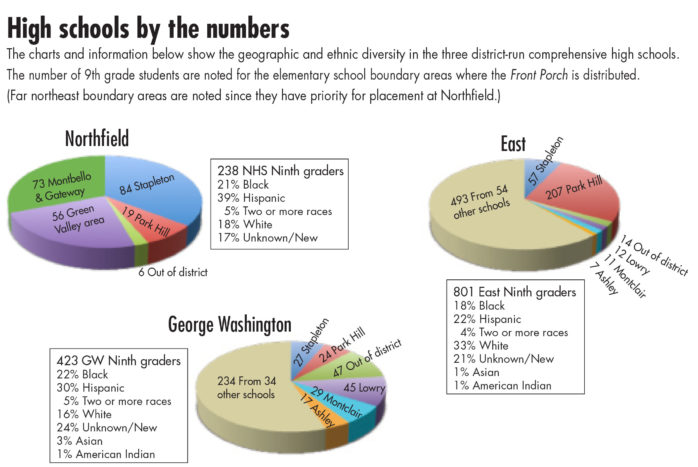
The charts and information show the geographic and ethnic diversity in the three district-run comprehensive high schools.
The number of 9th grade students are noted for the elementary school boundary areas where the Front Porch is distributed.
(Far northeast boundary areas are noted since they have priority for placement at Northfield.)
Despite being a small school (under 250 students per class and currently only having a 9th and 10th grade class), Principal Amy Bringedahl points out that NHS offers a wide range of electives including orchestra, choir, drama, stagecraft, art, engineering, PE classes, a Computer Science AP course, a Computer Science I course, and entrepreneurship, in addition to Chinese, French and Spanish. Porter adds that students can start in elective pathways, such as computer science or engineering, and follow a natural progression into potential IB courses of the same subject.
Principal Amy Bringedahl says NHS “hand schedules” all students to create balanced, diverse classroom groups and teachers are trained to offer a “tiered” curriculum that can be accessed by students at different levels. “It’s not uncommon one day for teachers to be grouping by student achievement levels and the next day they’re going to have heterogeneous groups for more discussion.”
In language arts, teachers may span differences in reading levels by assigning books at different levels on the same topic, but bringing everyone together for discussions that are enriched by the diversity of perspectives in the group. Students with higher levels of academic achievement might, for example, take notes independently as the teacher is talking, while other students would get partially filled in notes that they add to. Team teaching and paraprofessionals in the classroom also offer extra support to students who may be struggling.
IB wants to educate all students internationally from diverse perspectives that generate very rich and deep conversations, says Porter. Bringedahl recalls a recent example of how diversity can contribute to class discussions. In a unit on civil rights she observed some “Aha” moments when Caucasian students started to understand what that time period was like and the implications it had as the country moves forward. “Many of our students were very much of the opinion that if you were white you couldn’t understand it and understand what we had been through. Watching them have that conversation and learn from each other is one of the most powerful things that we have in education.”




0 Comments